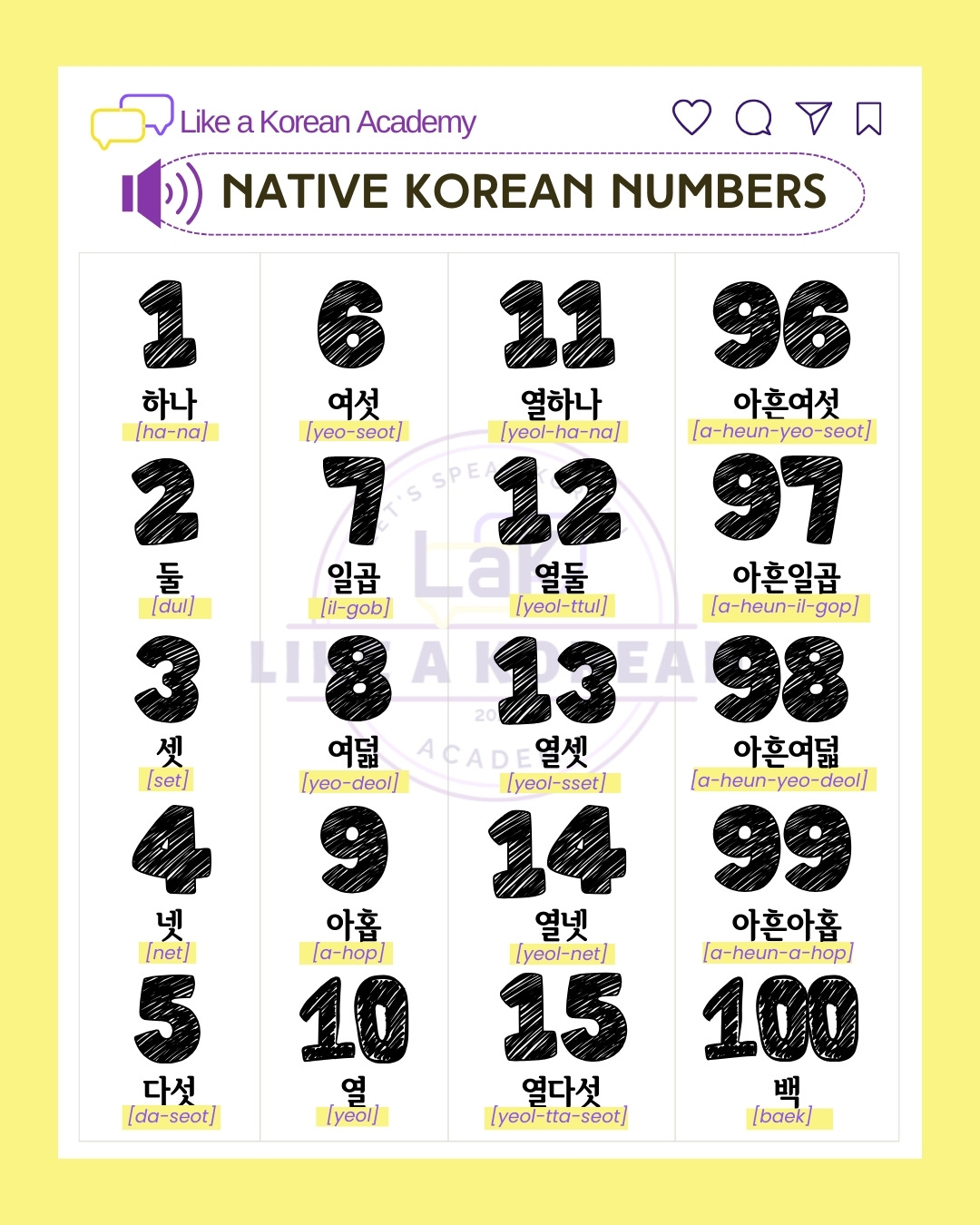A Guide to Korean Numbers
안녕하세요 (Annyeonghaseyo) language enthusiasts! Today, we’re into the fascinating world of Korean numbers – a crucial aspect of the language that not only helps you communicate but also unveils cultural traces. From everyday conversations to navigating through markets and understanding Korean age, mastering these numbers is a key step in your Korean language journey.
Korean language learners often encounter confusion in the use of both Native Korean numbers and Sino-Korean numbers. In Korean, there are 2 number systems: Native Korean numeral words and Sino-Korean numeral words. Native Korean numerals include words like ‘하나 hana (one), 둘 dul (two), 셋 set (three), 넷 net (four), 다섯 dasot (five),’ which are original Korean words used to represent numbers. On the other hand, Sino-Korean numerals are based on Chinese characters and include words like ‘일 il (one), 이 i (two), 삼 sam (three), 사 sa (four), 오 o (five).’
In Korean, numerals are used in a mixed manner based on context. Sino-Korean numerals are commonly used to denote size, standardized expressions, such as for money amounts, dates, and minutes. On the other hand, native Korean numerals are more frequently used in everyday conversations to emphasize counting or in expressing quantities. For instance, when counting items, ‘hana, dul, set…’ are used, while Sino-Korean numerals are often used for expressing monetary amounts.
| Native Korean numbers | Sino-Korean numbers |
| 하나 hana (one), 둘 dul (two), 셋 set (three), 넷 net (four), 다섯 dasot (five) | 일 il (one), 이 i (two), 삼 sam (three), 사 sa (four), 오 o (five) |
| count things (how many), age, time(in hours), | Counting money, price, big numbers (over 100), dates, time(minutes), phone numbers, address, floors |
| n살, n시, n시간, n달 n개, n명, n병, n권, n잔, n장, n대, n마리… | n세, n분, n월, n일, n주일, n개월, n년 n층 |
Let’s begin with native Korean numbers, which are used for counting objects up to 99. These numbers have a distinct set of words and are relatively straightforward to learn. Here’s a quick overview:
- 1 – 하나 (hana)
- 2 – 둘 (dul)
- 3 – 셋 (set)
- 4 – 넷 (net)
- 5 – 다섯 (daseot)
- 6 – 여섯 (yeoseot)
- 7 – 일곱 (ilgop)
- 8 – 여덟 (yeodeol)
- 9 – 아홉 (ahop)
- 10 – 열 (yeol)
The native Korean numbers 10, 20, and 30 have different names for each tens. A little complicated, right? So when Koreans talk about big numbers, they usually use sino-Korean numbers. However, since native language numbers are used when counting age, it is also a good idea to study your age in advance using native language numbers. Example: If you are 34 years old, you can say 서른네 살 (seu-mul-se sal).
- 10 – 열 (yeol)
- 20 – 스물 (seumul)
- 30 – 서른 (seoreun)
- 40 – 마흔 (maheun)
- 50 – 쉰 (swin)
- 60 – 예순 (yesun)
- 70 – 일흔 (ilheun)
- 80 – 여든 (yeodeun)
- 90 – 아흔 (aheun)
The pattern continues for numbers up to 99, combining the words for tens and ones. For instance, 23 would be 스물셋 (seumulset).

Sino-Korean numbers, on the other hand, are heavily influenced by Chinese characters and are used for counting larger quantities, money, dates, addresses, and more. Here are the Sino-Korean numbers for 1 to 10:
- 일 (il) – One
- 이 (i) – Two
- 삼 (sam) – Three
- 사 (sa) – Four
- 오 (o) – Five
- 육 (yuk) – Six
- 칠 (chil) – Seven
- 팔 (pal) – Eight
- 구 (gu) – Nine
- 십 (sip) – Ten
Now that you’ve got the hang of 1-10, it’s time to tackle numbers beyond. Korean uses a unique system, grouping numbers in sets of ten thousand. Here’s the trick:
- 10 – 십 (sip)
- 20 – 이십 (isip)
- 30 – 삼십 (samsip)
- 40 – 사십 (sasip)
- 50 – 오십 (osip)
- 60 – 육십 (yuksip)
- 70 – 칠십 (chilsip)
- 80 – 팔십 (palsip)
- 90 – 구십 (gusip)
- 100 – 백 (baek)
The unique aspect of Sino-Korean numbers lies in the way they combine to form larger numbers. For example, 365 would be 삼백육십오 (sambae-yuksip-o).

Understanding larger numbers is a piece of cake once you grasp the pattern. For example:
- 1,000 – 천 (cheon)
- 10,000 – 만 (man)
- 100,000 – 십만 (simman)
- 1,000,000 – 백만 (baengman)
Please note that 10,000 in Korean is not 십천 sip chen (ten + thousand). So, 11,000 becomes 만천 (mancheon), and 21,000 is 이만천 (imancheon).
Numbers in Korea often hold symbolic meanings. For instance, 3 (셋 – set) is considered a lucky number, and 4 (넷 – net) is associated with bad luck due to its pronunciation similarity to the word for ‘death.’ Dive into these cultural nuances to enhance your language skills and understanding of Korean society.
Mastering Korean numbers is a gateway to unlocking deeper cultural insights and seamless communication. Practice regularly, explore, and soon, you’ll be counting and conversing like a pro! If you’re interested in more language tips and cultural insights, stay tuned for our next adventure into the world of Korean language and beyond.
안녕히 가세요 (Annyeonghi gaseyo) – Until next time!





 My team and I are making it
My team and I are making it to provide some tips about learning Korean and how to practice Korean! Not only that, but we also want you to immerse yourself in the language and take a deep dive into Korean culture as well. So,…
to provide some tips about learning Korean and how to practice Korean! Not only that, but we also want you to immerse yourself in the language and take a deep dive into Korean culture as well. So,…